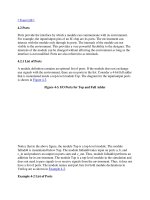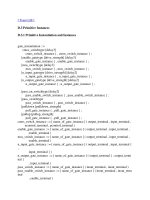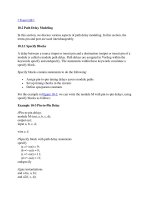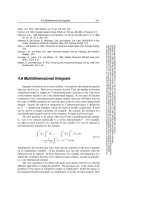Tài liệu Useful Modeling Techniques part 2 pptx
Bạn đang xem bản rút gọn của tài liệu. Xem và tải ngay bản đầy đủ của tài liệu tại đây (18.08 KB, 5 trang )
[ Team LiB ]
9.3 Conditional Compilation and Execution
A portion of Verilog might be suitable for one environment but not for another. The
designer does not wish to create two versions of Verilog design for the two environments.
Instead, the designer can specify that the particular portion of the code be compiled only
if a certain flag is set. This is called conditional compilation.
A designer might also want to execute certain parts of the Verilog design only when a
flag is set at run time. This is called conditional execution.
9.3.1 Conditional Compilation
Conditional compilation can be accomplished by using compiler directives `ifdef, `ifndef,
`else, `elsif, and `endif. Example 9-5
contains Verilog source code to be compiled
conditionally.
Example 9-5 Conditional Compilation
//Conditional Compilation
//Example 1
'ifdef TEST //compile module test only if text macro TEST is defined
module test;
endmodule
'else //compile the module stimulus as default
module stimulus;
endmodule
'endif //completion of 'ifdef directive
//Example 2
module top;
bus_master b1(); //instantiate module unconditionally
'ifdef ADD_B2
bus_master b2(); //b2 is instantiated conditionally if text macro
//ADD_B2 is defined
'elsif ADD_B3
bus_master b3(); //b3 is instantiated conditionally if text macro
//ADD_B3 is defined
'else
bus_master b4(); //b4 is instantiate by default
'endif
'ifndef IGNORE_B5
bus_master b5(); //b5 is instantiated conditionally if text macro
//IGNORE_B5 is not defined
'endif
endmodule
The `ifdef and `ifndef directives can appear anywhere in the design. A designer can
conditionally compile statements, modules, blocks, declarations, and other compiler
directives. The `else directive is optional. A maximum of one `else directive can
accompany an `ifdef or `ifndef. Any number of `elsif directives can accompany an `ifdef
or `ifndef. An `ifdef or `ifndef is always closed by a corresponding `endif.
The conditional compile flag can be set by using the `define statement inside the Verilog
file. In the example above, we could define the flags by defining text macros TEST and
ADD_B2 at compile time by using the `define statement. The Verilog compiler simply
skips the portion if the conditional compile flag is not set. A Boolean expression, such as
TEST && ADD_B2, is not allowed with the `ifdef statement.
9.3.2 Conditional Execution
Conditional execution flags allow the designer to control statement execution flow at run
time. All statements are compiled but executed conditionally. Conditional execution flags
can be used only for behavioral statements. The system task keyword $test$plusargs is
used for conditional execution.
Consider Example 9-6
, which illustrates conditional execution with $test$plusargs.
Example 9-6 Conditional Execution with $test$plusargs
//Conditional execution
module test;
initial
begin
if($test$plusargs("DISPLAY_VAR"))
$display("Display = %b ", {a,b,c} ); //display only if flag is set
else
//Conditional execution
$display("No Display"); //otherwise no display
end
endmodule
The variables are displayed only if the flag DISPLAY_VAR is set at run time. Flags can
be set at run time by specifying the option +DISPLAY_VAR at run time.
Conditional execution can be further controlled by using the system task keyword
$value$plusargs. This system task allows testing for arguments to an invocation option.
$value$plusargs returns a 0 if a matching invocation was not found and non-zero if a
matching option was found. Example 9-7
shows an example of $value$plusargs.
Example 9-7 Conditional Execution with $value$plusargs
//Conditional execution with $value$plusargs
module test;
reg [8*128-1:0] test_string;
integer clk_period;
initial
begin
if($value$plusargs("testname=%s", test_string))
$readmemh(test_string, vectors); //Read test vectors
else
//otherwise display error message
$display("Test name option not specified");
if($value$plusargs("clk_t=%d", clk_period))
forever #(clk_period/2) clk = ~clk; //Set up clock
else
//otherwise display error message
$display("Clock period option name not specified");
end
//For example, to invoke the above options invoke simulator with
//+testname=test1.vec +clk_t=10
//Test name = "test1.vec" and clk_period = 10
endmodule
[ Team LiB ]
[ Team LiB ]
9.4 Time Scales
Often, in a single simulation, delay values in one module need to be defined by using
certain time unit, e.g., 1 µs, and delay values in another module need to be defined by
using a different time unit, e.g. 100 ns. Verilog HDL allows the reference time unit for
modules to be specified with the `timescale compiler directive.
Usage: `timescale <reference_time_unit> / <time_precision>
The <reference_time_unit> specifies the unit of measurement for times and delays. The
<time_precision> specifies the precision to which the delays are rounded off during
simulation. Only 1, 10, and 100 are valid integers for specifying time unit and time
precision. Consider the two modules, dummy1 and dummy2, in Example 9-8
.
Example 9-8 Time Scales
//Define a time scale for the module dummy1
//Reference time unit is 100 nanoseconds and precision is 1 ns
`timescale 100 ns / 1 ns
module dummy1;
reg toggle;
//initialize toggle
initial
toggle = 1'b0;
//Flip the toggle register every 5 time units
//In this module 5 time units = 500 ns = .5 ms
always #5
begin
toggle = ~toggle;
$display("%d , In %m toggle = %b ", $time, toggle);
end
endmodule
//Define a time scale for the module dummy2
//Reference time unit is 1 microsecond and precision is 10 ns
`timescale 1 us / 10 ns
module dummy2;
reg toggle;
//initialize toggle
initial
toggle = 1'b0;
//Flip the toggle register every 5 time units
//In this module 5 time units = 5 ms = 5000 ns
always #5
begin
toggle = ~toggle;
$display("%d , In %m toggle = %b ", $time, toggle);
end
endmodule
The two modules dummy1 and dummy2 are identical in all respects, except that the time
unit for dummy1 is 100 ns and the time unit for dummy2 is 1 µs. Thus the $display
statement in dummy1 will be executed 10 times for each $display executed in dummy2.
The $time task reports the simulation time in terms of the reference time unit for the
module in which it is invoked. The first few $display statements are shown in the
simulation output below to illustrate the effect of the `timescale directive.
5 , In dummy1 toggle = 1
10 , In dummy1 toggle = 0
15 , In dummy1 toggle = 1
20 , In dummy1 toggle = 0
25 , In dummy1 toggle = 1
30 , In dummy1 toggle = 0
35 , In dummy1 toggle = 1
40 , In dummy1 toggle = 0
45 , In dummy1 toggle = 1
> 5 , In dummy2 toggle = 1
50 , In dummy1 toggle = 0
55 , In dummy1 toggle = 1
N
otice that the $display statement in dummy2 executes once for every ten $display
statements in dummy1.
[ Team LiB ]









